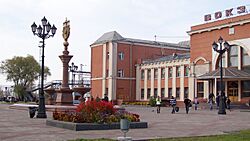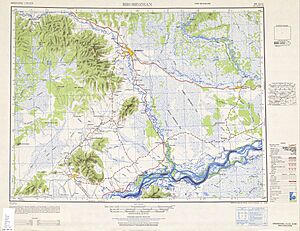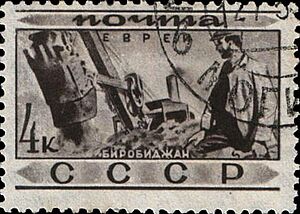Birobidzhan facts for kids
Quick facts for kids (English)Биробиджан (Russian) ביראָבידזשאן (Yiddish) |
|
|---|---|
| - Town - | |
 Birobidzhan railway station |
|
|
|
|
| Town Day | Last Saturday of May |
| Administrative status | |
| Country | Russia |
| Federal subject | Jewish Autonomous Oblast |
| Administratively subordinated to | town of oblast significance of Birobidzhan |
| Municipal status | |
| Urban okrug | Birobidzhan Urban Okrug |
| Mayor | Aleksandr Golovaty |
| Representative body | Town Duma |
| Statistics | |
| Area | 169.38 km2 (65.40 sq mi) |
| Population (2010 Census, preliminary) |
75,413 inhabitants |
| - Rank in 2010 | 215th |
| Population (January 2014 est.) | 74,791 inhabitants |
| Density | 445/km2 (1,153/sq mi) |
| Time zone | VLAT (UTC+11:00) |
| Founded | 1931 |
| Town status since | 1937 |
| Postal code(s) | 679000, 679002, 679005, 679006, 679011, 679013–679017, 679700, 679801, 679950 |
| Dialing code(s) | +7 42622 |
| Official website: http://www.biradm.ru/ | |
Birobidzhan is a town in Russia. It is the main city of the Jewish Autonomous Oblast. The town is located on the Trans-Siberian Railway. It is also close to the border with China.
In 2010, about 75,413 people lived here. Yiddish is an official language in the region. Birobidzhan gets its name from two rivers: the Bira and the Bidzhan. The Bira River flows right through the town. Both rivers flow into the larger Amur River.
Contents
History of Birobidzhan
Birobidzhan was planned by a Swiss architect named Hannes Meyer. It was started in 1931. In 1934, it became the main city of the Jewish Autonomous Oblast. It officially became a town in 1937.
The Soviet government wanted to create a special home for Jewish people. This plan was called the Birobidzhan Experiment. They used the slogan "To the Jewish Homeland!" to encourage Jewish workers to move there. Many Jewish people from the Soviet Union and other countries moved to Birobidzhan. Some even came from Argentina and the United States.
Why the Birobidzhan Experiment Happened
The Soviet government had several reasons for creating Birobidzhan. They wanted to give Jewish people a place to live. They also wanted to use the area as a protective zone near the Chinese border. The region was also important because it connected the Trans-Siberian Railroad to the Amur River. The government also wanted to use the natural resources there, like fish, wood, and metals.
Challenges During the Experiment
Settling in Birobidzhan was very difficult. There was not enough housing or good roads. The weather was also very harsh. Because of these problems, more than half of the Jewish settlers did not stay.
Later, during a tough time in Soviet history, Jewish people in Birobidzhan faced problems. After World War II, many Jewish people from Eastern Europe moved there. But soon after, they faced more difficulties. Many Jewish cultural places in Birobidzhan were closed down.
People Who Supported Birobidzhan
Many people supported the idea of Birobidzhan. One supporter was Dudley Aman, 1st Baron Marley from England. He visited the area and became a strong supporter.
David Bergelson, a Yiddish writer, also helped promote Birobidzhan. He wrote articles saying it was a great place to escape from unfair treatment. Many families from the United States and Latin America moved there because of his writings.
Even a Canadian explorer, Vilhjalmur Stefansson, supported the idea. He helped an organization that assisted Jewish families moving to Birobidzhan.
Jewish and Yiddish Culture
The Russian Empire once had the largest Jewish population in the world. Many of them stayed even after the Soviet Union was formed. While thousands moved to Birobidzhan, many left because of the difficulties. By the mid-2010s, only about 2,000 Jewish people remained.
Yiddish was seen as a very important language for the Jewish community. It was meant to help Jewish people fit into Soviet society. Many officials thought Birobidzhan would become a major center for Jewish life.
The Jewish religious community in Birobidzhan was officially recognized in 1946. Jewish culture started to come back in Birobidzhan earlier than in other parts of the Soviet Union. Yiddish theaters opened in the 1970s.
Since the early 1990s, Yiddish and Jewish traditions have been taught in public schools. They are seen as part of the region's history. The main synagogue was finished in 2004. It has classrooms, a library, and a museum.
Rabbi Eliyahu Riss is the current Chief Rabbi of Birobidzhan. He was born in Birobidzhan. He wants to bring back Jewish culture to the area. He plans to open a kosher restaurant, a supermarket, and a ritual bath. He says Birobidzhan is a safe place for Jewish people.
The town's main street is named after Sholem Aleichem. He was a famous Yiddish writer and humorist. In 2007, for the Chanukah celebration, officials claimed to have built the world's largest menorah.
Government and Administration
Birobidzhan is the main city of the Jewish Autonomous Oblast. It serves as the administrative center for the region. This means it's where the main government offices are located.
Economy and Transportation
Birobidzhan's main industries are light manufacturing. This includes making textiles and shoes. There are also factories for vehicle repair, furniture, and food products.
The closest major airport is Khabarovsk Novy Airport. It is about 198 kilometers (123 miles) away.
Education
The Sholem Aleichem Amur State University is in Birobidzhan. It works with the local Jewish community. This university is special in the Russian Far East. It teaches Hebrew language, history, and classic Jewish texts.
The town has several public schools that teach Yiddish. There is also a Yiddish school for religious lessons. A kindergarten teaches Yiddish, songs, and traditions to young children. About half the students in one public school choose to learn Yiddish and Jewish culture. Many continue this learning through high school.
Climate
Birobidzhan has a climate with very big differences between seasons. Summers are warm to hot and often humid. Winters are very cold and dry. January has never had a temperature above freezing!
| Climate data for Birobidzhan | |||||||||||||
|---|---|---|---|---|---|---|---|---|---|---|---|---|---|
| Month | Jan | Feb | Mar | Apr | May | Jun | Jul | Aug | Sep | Oct | Nov | Dec | Year |
| Record high °C (°F) | −0.4 (31.3) |
5.9 (42.6) |
18.4 (65.1) |
29.8 (85.6) |
33.7 (92.7) |
37.1 (98.8) |
39.9 (103.8) |
36.8 (98.2) |
32.7 (90.9) |
26.9 (80.4) |
16.1 (61.0) |
5.2 (41.4) |
39.9 (103.8) |
| Mean daily maximum °C (°F) | −15.6 (3.9) |
−10.9 (12.4) |
0.2 (32.4) |
9.5 (49.1) |
18.2 (64.8) |
24.5 (76.1) |
26.8 (80.2) |
24.3 (75.7) |
18.1 (64.6) |
8.5 (47.3) |
−4.1 (24.6) |
−14.2 (6.4) |
7.0 (44.6) |
| Daily mean °C (°F) | −22.2 (−8.0) |
−16.5 (2.3) |
−6.4 (20.5) |
5.4 (41.7) |
13.0 (55.4) |
18.9 (66.0) |
21.1 (70.0) |
19.2 (66.6) |
12.8 (55.0) |
3.9 (39.0) |
−9.2 (15.4) |
−18.8 (−1.8) |
1.9 (35.4) |
| Mean daily minimum °C (°F) | −27.4 (−17.3) |
−26.4 (−15.5) |
−16.5 (2.3) |
−3.4 (25.9) |
5.0 (41.0) |
12.5 (54.5) |
15.1 (59.2) |
13.4 (56.1) |
5.9 (42.6) |
−1.3 (29.7) |
−16.9 (1.6) |
−26.6 (−15.9) |
−3.6 (25.5) |
| Record low °C (°F) | −43.7 (−46.7) |
−39.9 (−39.8) |
−34.1 (−29.4) |
−19.7 (−3.5) |
−3.9 (25.0) |
1.5 (34.7) |
5.9 (42.6) |
3.7 (38.7) |
−3.9 (25.0) |
−19.8 (−3.6) |
−33.6 (−28.5) |
−37.9 (−36.2) |
−43.7 (−46.7) |
| Average precipitation mm (inches) | 6 (0.2) |
5 (0.2) |
13 (0.5) |
35 (1.4) |
61 (2.4) |
108 (4.3) |
147 (5.8) |
154 (6.1) |
88 (3.5) |
35 (1.4) |
19 (0.7) |
11 (0.4) |
682 (26.9) |
| Average precipitation days | 2 | 2 | 4 | 6 | 10 | 12 | 13 | 13 | 10 | 5 | 4 | 3 | 84 |
| Source 1: World Meteorological Organisation (UN) | |||||||||||||
| Source 2: [www.retscreen.net/ru/home.php NASA RETScreen Database] | |||||||||||||
Sports
The local bandy club is called Nadezhda. They used to play in the second-highest league in Russia.
Twin Towns – Sister Cities
Birobidzhan has "sister city" relationships with several other cities around the world:
 Beaverton, OR, United States
Beaverton, OR, United States Niigata, Japan
Niigata, Japan Hegang, China
Hegang, China Yichun, China
Yichun, China Ma'alot-Tarshiha, Israel
Ma'alot-Tarshiha, Israel Nof HaGalil, Israel
Nof HaGalil, Israel
Notable People
- Nataliya Gumenyuk, a journalist and teacher
See also
 In Spanish: Birobidzhán para niños
In Spanish: Birobidzhán para niños





